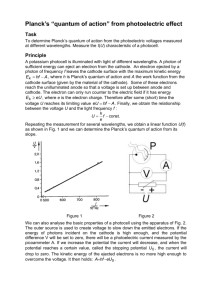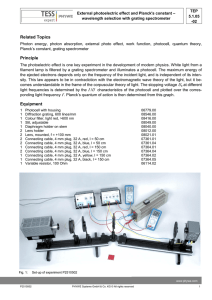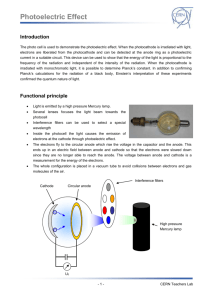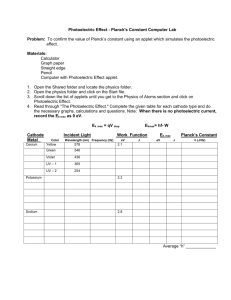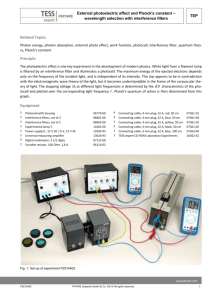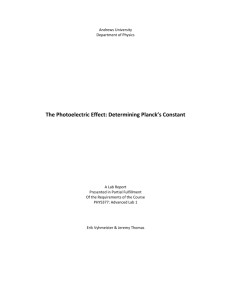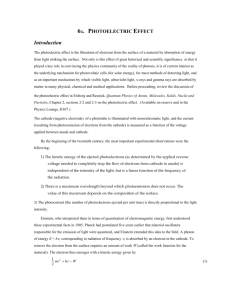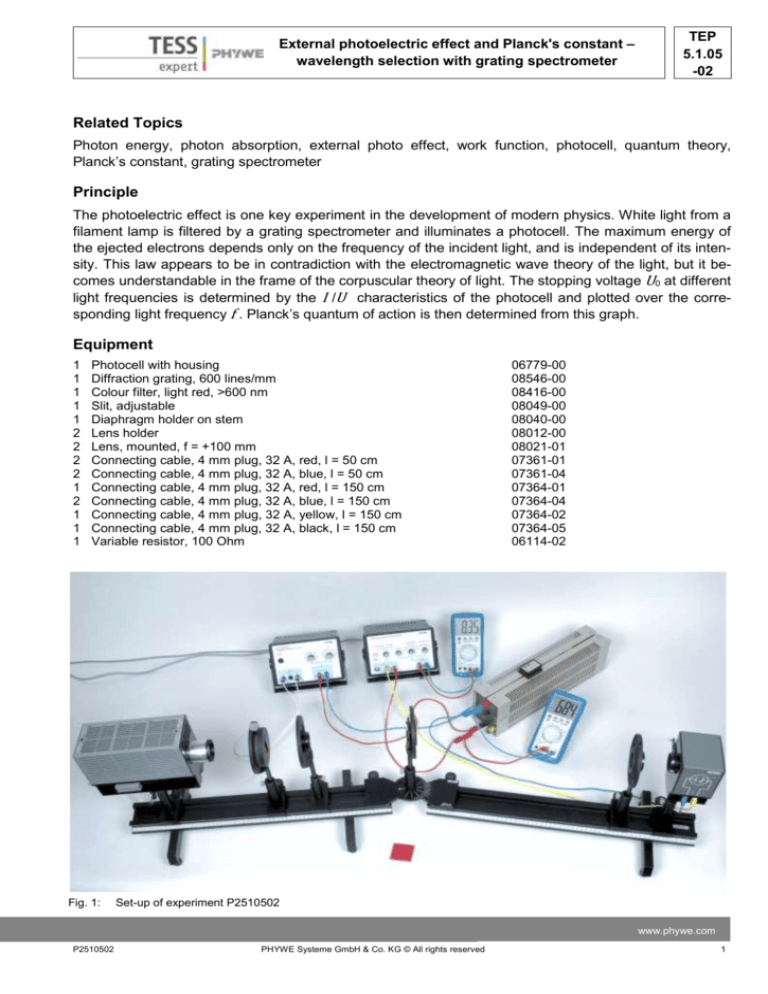
External photoelectric effect and Planck's constant –
wavelength selection with grating spectrometer
TEP
5.1.05
-02
Related Topics
Photon energy, photon absorption, external photo effect, work function, photocell, quantum theory,
Planck’s constant, grating spectrometer
Principle
The photoelectric effect is one key experiment in the development of modern physics. White light from a
filament lamp is filtered by a grating spectrometer and illuminates a photocell. The maximum energy of
the ejected electrons depends only on the frequency of the incident light, and is independent of its intensity. This law appears to be in contradiction with the electromagnetic wave theory of the light, but it becomes understandable in the frame of the corpuscular theory of light. The stopping voltage U0 at different
light frequencies is determined by the I /U characteristics of the photocell and plotted over the corresponding light frequency f . Planck’s quantum of action is then determined from this graph.
Equipment
1
1
1
1
1
2
2
2
2
1
2
1
1
1
Photocell with housing
Diffraction grating, 600 lines/mm
Colour filter, light red, >600 nm
Slit, adjustable
Diaphragm holder on stem
Lens holder
Lens, mounted, f = +100 mm
Connecting cable, 4 mm plug, 32 A, red, l = 50 cm
Connecting cable, 4 mm plug, 32 A, blue, l = 50 cm
Connecting cable, 4 mm plug, 32 A, red, l = 150 cm
Connecting cable, 4 mm plug, 32 A, blue, l = 150 cm
Connecting cable, 4 mm plug, 32 A, yellow, l = 150 cm
Connecting cable, 4 mm plug, 32 A, black, l = 150 cm
Variable resistor, 100 Ohm
Fig. 1:
06779-00
08546-00
08416-00
08049-00
08040-00
08012-00
08021-01
07361-01
07361-04
07364-01
07364-04
07364-02
07364-05
06114-02
Set-up of experiment P2510502
www.phywe.com
P2510502
PHYWE Systeme GmbH & Co. KG © All rights reserved
1
TEP
5.1.0502
1
1
1
1
1
1
2
2
3
1
5
External photoelectric effect and Planck's constant – wavelength selection with grating spectrometer
Experimental lamp 2
Halogen lamp, 12 V, 50 W
Holder G 3.65 for 50/100 W halogen lamp
Double condensor, f = 60 mm
DC constanter
Universal measuring amplifier
Digital multimeter, 3 1/2 digits
Optical profile bench, l = 600 mm
Base for optical profile bench, adjustable
Turning knuckle for optical profile bench
Slide mount for optical profil bench, h = 80 mm
08129-01
08129-06
08129-04
08137-00
13505-93
13626-93
07122-00
08283-00
08284-00
08285-00
08286-02
Tasks
1. Calculate the light frequency f in dependence on the spectrometer angle
2. Experimentally determine the stopping voltage U0 for different light frequencies and plot it over light
frequency f.
3. Calculate Planck’s constant from the dependence of the stopping voltage U0 on the light frequency f.
Set-up and Procedure
The experiment for the demonstration of
the photoelectric effect is formed by: a
photoelectric cell, the cathode of which is
irradiated with a light beam characterized
by the frequency f; a potentiometer allowing to apply on the cell anode a voltage U
(positive or negative with respect to the
cathode); a voltmeter to measure this
voltage; a microamperemeter to measure
the photoelectric current I.
-
Set up the two optical benches with
turning knuckle such that the arrangement stands firmly on the table
and the right bench can be turned
-
Position the lamp at 9.0 cm, the slit at Fig. 2: Circuit diagram for the experiment
34.0 cm and the first 100 mm-lens at
44.0 cm from the left end of the left optical bench and turn on the lamp
-
Set the slit width to about the same as photocell entrance slit width
-
move the lamp holder inside the lamp housing to focus the light coming out of the lamp on the plane
of the slit
-
Move the lens such that the light is parallel after the lens – you can assess the beam at the next wall
-
Insert the 600 lines per mm grating into the diaphragm holder in the centre of the turning knuckle
-
Align the grating lines vertical by observing the spectra on surrounding surfaces – same height to both
sides of the grating
-
Put the photocell to the right end of the right optical bench, use the slit entrance of the housing
-
Focus the illuminating slit into the slit entrance of the photocell with the other 100 mm lens inserted in
front of the photocell
-
Record the angle as zero-angle, where all the undiffracted light enters the photocell entrance slit
2
PHYWE Systeme GmbH & Co. KG © All rights reserved
P2510502
External photoelectric effect and Planck's constant –
wavelength selection with grating spectrometer
-
Do the electrical connections as in Fig. 2
-
Set the measuring amplifier to low drift mode, amplification 105 and time constant 0.3 s
-
TEP
5.1.05
-02
Check zeroing of universal amplifier – with no connection on the input set the amplifier output voltage
to zero with the zeroing button
-
Set the power supply voltage on the potentiometer to 3 V, current to 1 A.
-
Observe the amplifier output which is proportional to photo current in dependence on photocell bias
voltage
-
Measure the bias voltage for zero current for different angles in the first order diffraction spectrum of
the lamp – for the 600 l /mm grating 13° to 25°.
-
As soon as the light can pass the red filter (ca. above 21 ° diffraction angle), use the filter to prevent
second order UV light to disturb the measurement.
Remarks on operation:
The measuring amplifier input has a resistance of 10,000 Ohm. If the amplifier is set to amplification 10 4,
then one volt at the amplifier output corresponds to 0.0001 V at the input and thus to a current of 10 nA.
The time constant is set to avoid errors due to mains hum influence. The vernier scale at the turning
knuckle can be read as follows: Take the next lower angle reading on the scale on the inside near the
zero mark of the scale on the outside and add the angle reading of the vernier, where the lines of the
vernier (outside, moving) and the lines of the scale on the round plate (fixed, at centre) coincide, see example on Fig. 3.
Theory and evaluation
The external photoelectric effect was first described in
1886 by Heinrich Hertz. It soon became clear that this effect shows certain characteristics that cannot be explained by the classical wave theory of light. For example, when the intensity of the light shining on a metal becomes more intense, the classical wave theory would expect that the electrons liberated from the metal would absorb more energy. However, experiments showed that
the maximum possible energy of the ejected electrons
depends only on the frequency of the incident light and is
independent of its intensity.
The theoretical explanation was given by Einstein in
1905. He suggested that light could be considered to
behave like particles in some respect, moving with a constant velocity (the speed of light in vacuum) and possessing the energy E = hf. Einstein's explanation of the
photoelectric effect, demonstrating the particle-like light
behavior of photons, contributed to the development of
quantum theory. Thus, the external photoelectric effect is
one of the key experiments in the development of mod- Fig. 3: Example for reading the vernier scale: The
next lowest mark near the zero mark is
ern physics and Einstein obtained the Nobel Prize in
15°, the next marks coinciding are at 1.5°,
Physics “for his discovery of the law of the photoelectric
so the angle reads 16.5°
effect“.
www.phywe.com
P2510502
PHYWE Systeme GmbH & Co. KG © All rights reserved
3
TEP
5.1.0502
External photoelectric effect and Planck's constant – wavelength selection with grating spectrometer
Task 1: Calculate the light frequency f in dependence on the spectrometer angle
The frequency of the light irradiating the photocell is determined using the following equation:
d . sin = n . (1)
= arcsin (/d)
(2)
is the spectrometer angle, d is the constant of the grating (here: 1/600 mm), is the wavelength of the
emitted light and the order of diffraction n is 1 in this case.
The light frequency f
c = 299 792 458 m/s.
can be calculated from the wavelength by f = c / with speed of light
Task 2: Determine the stopping voltage U0 experimentally for different light frequencies and plot it over
the light frequency f.
Inside the photo-cell, a cathode with special low-work function coating is situated together with a metal
anode in a vacuum tube. If a photon of frequency f strikes the cathode, then an electron can be liberated from the cathode material (external photoelectric effect) if the photon energy is sufficient.
If the emitted electrons reach the anode, they are absorbed by it due to the anode work function and the
result is a photo current.
The photoelectric effect is an interaction of a photon with an electron. In this reaction momentum and
energy are conserved, the electron absorbs the photon and has after the reaction the full photon energy
h f . If the energy of the photon h f is greater than the extraction work WC (cathode work function), the
electron can after the reaction leave the substance with a maximum kinetic energy Wkin = h f – WC. This
is called external photoelectric effect and described by:
hf
= WC + Wkin (Einstein’s equation) (3)
The kinetic energy Wkin for the emitted electrons is determined using the stopping electric field method: A
negative bias with respect to the cathode is applied on the photoelectric cell anode. This decelerates the
electrons and thus decreases the photoelectric current intensity I since not all electrons have maximum
Table 1: Results
energy but they have an energy distribution. The value of the bias where no electron reaches the anode
and I becomes zero is called stopping voltage and is spectrometer
λ/nm
f /1012 Hz
U0/V
angle
quoted U0.
Plotting I over the applied bias voltage Ubias reveals
the dependence of U0 on the wavelength λ of the incident light.
Task 3: Calculate Planck’s constant from the dependence of the stopping voltage on the light frequency.
Electrons can only reach the anode if their kinetic energy Wkin is greater than the energy they lose flying
against the direction of the electric field created by
the bias voltage Ubias plus the unknown electric field
due to the contact voltage UAC between the anode
4
13,5
389
772
1,3
14
403
744
1,2
15
431
696
1,05
16,5
473
634
0,9
18
515
582
0,7
19
543
552
0,55
20
570
526
0,47
22
624
480
0,32
24
678
442
0,25
PHYWE Systeme GmbH & Co. KG © All rights reserved
P2510502
External photoelectric effect and Planck's constant –
wavelength selection with grating spectrometer
TEP
5.1.05
-02
Fig. 4: The photoelectric current intensity I as a function of the bias voltage at different frequencies of the irradiated light
and cathode, which has the same direction as the bias voltage, see Fig 3.
As the contact voltage is in the same order of magnitude as the bias voltage, we cannot neglect it.
Therefore, it is not possible to determine the absolute kinetic energy of the electrons. Nevertheless, the
Planck’s constant can be calculated from the dependence of the stopping voltage on the light frequency,
as the following considerations show:
At the stopping voltage U0, the kinetic energy Wkin of the electron equals the energy lost in the electric
field eU (U including the stopping voltage U0 and the contact voltage UAC):
e (U0 + UAC)
= Wkin
(4)
The contact voltage is calculated from the electrochemical potentials of anode UA and cathode UC . Multiplication of both with electron charge e = 1.602·10-19 As gives their corresponding work functions WA and
WC. So equation (4) is equivalent to
eU0 + WA – WC = Wkin
(5)
To calculate Planck’s constant h using the photoelectric effect, we compare (5) with Einstein
equation (3):
Wkin = eU0 + WA – WC = h f – WC
(6)
Accordingly, the cathode work function does not
appear in the formula for the stopping voltage
and (6) can be written as the following linear
function
eU0
= h f – WA
or
Fig. 5: Energy diagram for electrons in a photocell illuminated with λ = 436 nm/f =688 THz and bias U0 = 1 V
www.phywe.com
P2510502
PHYWE Systeme GmbH & Co. KG © All rights reserved
5
TEP
5.1.0502
U0
External photoelectric effect and Planck's constant – wavelength selection with grating spectrometer
= f . h / e – UA
(7)
As UA is a constant, a linear relationship exists between the stopping voltage U0 and the light frequency
f. The slope of the linear function gives Planck's constant h.
The measured slope is:
0.00329 V/THz
Multiplication with e gives: h = 5.27 . 10-34 Js
The calculated value may deviate ± 25 % from the literature value: h = 6.62 · 10-34 Js.
Notes
The cathode work function does not appear in the formula for the stopping voltage. This is due to the fact
that the electrons come from Fermi-level in the cathode and then have to reach the anode surface and
thus already have been able to pass the cathode surface.
The cathode work function on the other hand determines whether the photon energy is sufficient to liberate an electron from the cathode. Historically, this photoeffect threshold wavelength was also important
for the discovery of this effect and only later was understood when the electron energy spectrum of the
liberated electrons was systematically examined in dependence on light frequency and intensity.
Determining the stopping voltage U0 you will find curves having only a small slope when crossing the xaxis (zero point). An exact determination of the stopping voltage is therefore complicated.
There is a negative current for higher bias voltages. This current is due to the photo current from anode
to cathode. Also from the anode electrons can be liberated. The number of electrons there also depends
on light frequency and in a different way than for the cathode. It can be assumed, that the intensity and
wavelength sensitivity of the reverse photo electron current anode to cathode is different from the one of
the larger cathode to anode electron current. So the zero point shift per light intensity due to this effect is
Fig. 6:
6
Stopping voltage U0 as a function o the frequency of the irradiated light.
PHYWE Systeme GmbH & Co. KG © All rights reserved
P2510502
External photoelectric effect and Planck's constant –
wavelength selection with grating spectrometer
TEP
5.1.05
-02
different for different wavelengths making the zero point of the U /I characteristic curve of the photocell a
not very reliable measure.
The overall reverse current can nevertheless be regarded as small because of the far lower work function of the cathode compared to the anode. This justifies to neglect this effect.
Else the zero point shift in dependence on intensity would have to be measured for each wavelength and
would have to be taken into account trying to achieve a normalization with respect to intensity.
Since effects of the electron energy distribution are also present, the gain in precision by this procedure
will not be so great as to generally recommend it. Both the work function for the electrons to leave the
substance and the electron energy before the reaction with the photon have no sharp extrema so that
the overall achievable precision of this method is limited.
For a precise measurement of Planck's constant X-ray measurements are more suitable, but the photoelectric effect experiment has its justification by its great historic relevance.
www.phywe.com
P2510502
PHYWE Systeme GmbH & Co. KG © All rights reserved
7
TEP
5.1.0502
External photoelectric effect and Planck's constant – wavelength selection with grating spectrometer
Space for notes
8
PHYWE Systeme GmbH & Co. KG © All rights reserved
P2510502

